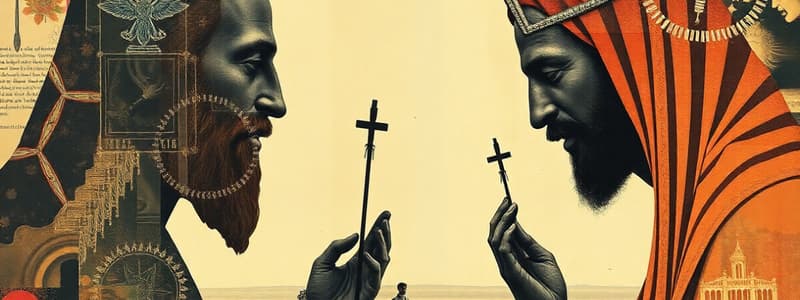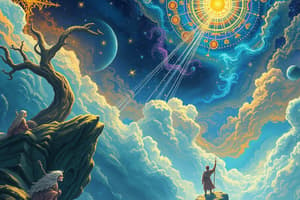Podcast
Questions and Answers
What is a core belief of Buddhism?
What is a core belief of Buddhism?
- Moksha
- The Trinity
- The covenant with God
- The Four Noble Truths (correct)
Which religious text is associated with Hinduism?
Which religious text is associated with Hinduism?
- The Vedas (correct)
- The Quran
- The Torah
- The Bible
What was a significant impact of the Indian Ocean Trade?
What was a significant impact of the Indian Ocean Trade?
- The establishment of monotheism
- The rise of powerful trading cities (correct)
- The spread of Christianity
- The fall of the Roman Empire
What distinguishes Shi’a Islam from Sunni Islam?
What distinguishes Shi’a Islam from Sunni Islam?
Who is considered the founder of Christianity?
Who is considered the founder of Christianity?
Which caliphate is associated with the golden age of science and culture?
Which caliphate is associated with the golden age of science and culture?
What concept is central to Hindu beliefs regarding the cycle of life and rebirth?
What concept is central to Hindu beliefs regarding the cycle of life and rebirth?
Which of the following religions emphasizes submission to Allah as a core belief?
Which of the following religions emphasizes submission to Allah as a core belief?
What was a significant characteristic of the Safavid Empire?
What was a significant characteristic of the Safavid Empire?
Which of the following best describes the impact of Mansa Musa on trade in West Africa?
Which of the following best describes the impact of Mansa Musa on trade in West Africa?
How did geography influence trade in Africa?
How did geography influence trade in Africa?
What was a notable effect of the Black Death on Europe?
What was a notable effect of the Black Death on Europe?
What motivated the Crusades in the medieval period?
What motivated the Crusades in the medieval period?
What is a major characteristic of feudalism in Europe?
What is a major characteristic of feudalism in Europe?
What was the impact of the printing press on society?
What was the impact of the printing press on society?
What characterized the characteristics and impacts of absolute monarchies?
What characterized the characteristics and impacts of absolute monarchies?
Which trade network was known for the exchange of silk and technology?
Which trade network was known for the exchange of silk and technology?
What triggered the Protestant Reformation in Europe?
What triggered the Protestant Reformation in Europe?
Which of the following describes the Middle Passage?
Which of the following describes the Middle Passage?
What was a common result of Columbus's voyages?
What was a common result of Columbus's voyages?
Which movement emphasized reason and individual rights during the Enlightenment?
Which movement emphasized reason and individual rights during the Enlightenment?
Which characteristic was prevalent in Japan's feudal system?
Which characteristic was prevalent in Japan's feudal system?
Flashcards
Christianity
Christianity
A monotheistic religion based on the teachings of Jesus Christ, emphasizing the Trinity, salvation through faith, and the Bible as sacred scripture.
Hinduism
Hinduism
A diverse and ancient religion originating in the Indian subcontinent, encompassing beliefs like karma, dharma, reincarnation (samsara), and liberation (moksha).
Buddhism
Buddhism
A religion founded by Siddhartha Gautama (the Buddha) in India, teaching the Four Noble Truths and the Eightfold Path to attain enlightenment and end suffering.
Judaism
Judaism
Signup and view all the flashcards
Islam
Islam
Signup and view all the flashcards
Indian Ocean Trade
Indian Ocean Trade
Signup and view all the flashcards
Umayyad Caliphate
Umayyad Caliphate
Signup and view all the flashcards
Abbasid Caliphate
Abbasid Caliphate
Signup and view all the flashcards
Safavid Empire: Key Features
Safavid Empire: Key Features
Signup and view all the flashcards
Mughal Empire: Cultural Fusion
Mughal Empire: Cultural Fusion
Signup and view all the flashcards
Geography and Trade: Camels in Africa
Geography and Trade: Camels in Africa
Signup and view all the flashcards
Gold and Power: Natural Resources in African Empires
Gold and Power: Natural Resources in African Empires
Signup and view all the flashcards
Islam's Impact on West Africa
Islam's Impact on West Africa
Signup and view all the flashcards
European Feudalism: System and Church Influence
European Feudalism: System and Church Influence
Signup and view all the flashcards
Japanese Feudalism: Samurai and Religion
Japanese Feudalism: Samurai and Religion
Signup and view all the flashcards
Causes and Impacts of the Crusades
Causes and Impacts of the Crusades
Signup and view all the flashcards
The Black Death: Pandemic and Consequences
The Black Death: Pandemic and Consequences
Signup and view all the flashcards
The Renaissance: Humanism and Advancements
The Renaissance: Humanism and Advancements
Signup and view all the flashcards
Printing Press: Communication Revolution
Printing Press: Communication Revolution
Signup and view all the flashcards
Causes and Effects of the Protestant Reformation
Causes and Effects of the Protestant Reformation
Signup and view all the flashcards
Mongol Impact: Trade, Conquest, and Connections
Mongol Impact: Trade, Conquest, and Connections
Signup and view all the flashcards
China's Civil Service System: Meritocracy and Efficiency
China's Civil Service System: Meritocracy and Efficiency
Signup and view all the flashcards
Isolation in China and Japan: Preservation and Limitation
Isolation in China and Japan: Preservation and Limitation
Signup and view all the flashcards
Study Notes
Major Religions
-
Christianity: Originated in 1st-century CE Judea, based on Jesus Christ's teachings. Key beliefs include the Trinity (Father, Son, Holy Spirit), salvation through faith, and the Bible as scripture.
-
Hinduism: Developed in the Indian subcontinent, one of the oldest religions. Key beliefs encompass karma, dharma, reincarnation (samsara), and liberation (moksha). Sacred texts include the Vedas and Upanishads.
-
Buddhism: Founded by Siddhartha Gautama (Buddha) in 5th-6th century BCE India. Core teachings focus on the Four Noble Truths and the Eightfold Path to enlightenment and ending suffering.
-
Judaism: A monotheistic religion of Hebrews, tracing back to Abraham and Moses. Central beliefs center on covenant with God and adherence to the Torah.
-
Islam: Originated in 7th-century CE Arabia with the prophet Muhammad. Islam emphasizes submission to Allah. Core beliefs include the Five Pillars of Islam and the Quran as scripture.
Indian Ocean Trade (c. 800-1500 CE)
-
Connected East Africa, the Middle East, South Asia, and Southeast Asia.
-
Navigated using monsoon winds.
-
Exchanged goods like spices, textiles, ivory, and gold.
-
Promoted spread of technology, religion (especially Islam), and cultural practices.
-
Led to economic prosperity, cultural exchange, and development of powerful trading cities like Malacca and Zanzibar.
Islamic Caliphates (Umayyad and Abbasid)
-
Umayyad Caliphate (661-750 CE): Rapid expansion across North Africa, Spain, and the Middle East. Promoted Arabic as an administrative language and established a vast trade network.
-
Abbasid Caliphate (750-1258 CE): Centered in Baghdad, fostered a golden age of science, literature, and culture. Significant advancements in medicine, mathematics, and philosophy.
Sunni and Shi'a Islam
-
Sunni: Believe the first four caliphs were rightful successors to Muhammad. Leadership is not based on hereditary lineage.
-
Shi'a: Believe only Ali (Muhammad's cousin) and his descendants are legitimate leaders. This split arose after Muhammad's death.
Islamic "Gunpowder Empires"
-
Ottoman Empire: Spanning Europe, Asia, and Africa. Known for military strength, efficient administration, and cultural achievements.
-
Safavid Empire: Centered in Persia, promoted Shi'a Islam and fostered cultural advancements in art, architecture, etc.
-
Mughal Empire: Ruled most of India, blending Persian and Indian cultures. Famous for architectural achievements, including the Taj Mahal.
Africa: Geography, Camels, and Resources
-
African geography (deserts, rivers) shaped trade routes.
-
Camels revolutionized trans-Saharan trade, facilitating movement of salt, gold, and other goods.
-
Natural resources (especially gold) enriched empires like Mali.
Islam in West Africa and Mansa Musa
-
Islam's influence on West Africa affected governance, law, and education.
-
Mansa Musa, a Malian ruler, significantly expanded trade and wealth. His pilgrimage to Mecca showcased Mali's prosperity.
Feudalism in Europe and Japan
-
Europe: System of lords, vassals, and serfs with manorial economies. Catholic Church was a major power.
-
Japan: Samurai warriors served daimyos. Shinto and Zen Buddhism influenced culture. Both systems emphasized loyalty and hierarchy.
Crusades
-
Causes: Religious zeal for reclaiming the Holy Land, desire for wealth and land, and papal influence.
-
Impacts: Increased trade between Europe and the Middle East, weakened feudalism, and strained Christian-Muslim relations.
The Black Death (1347-1351)
-
Bubonic plague pandemic that spread through trade routes.
-
Decimated Europe's population, causing economic decline, social upheaval, and weakened Church authority.
Renaissance
-
Emphasized humanism, secularism, and revival of classical learning.
-
Spurred advancements in art, science, and exploration. Figures like Leonardo da Vinci and Galileo emerged.
Printing Press
-
Invented by Johannes Gutenberg, revolutionized communication.
-
Made books affordable, spread ideas rapidly, and contributed to the Reformation and Scientific Revolution.
Protestant Reformation
-
Causes: Church corruption (including sale of indulgences), and Martin Luther's 95 Theses.
-
Impacts: Religious division, rise of Protestant churches, and religious wars.
Mongol Empire
-
Facilitated trade across Eurasia (Pax Mongolica).
-
Introduced technologies and connected China and Europe.
-
Conquests were often destructive.
China's Civil Service System
-
Based on Confucian principles, selecting officials through examinations.
-
Promoted meritocracy, stability, and bureaucracy.
Isolationism in China and Japan
-
Limited foreign trade and contact to preserve traditional culture.
-
Restricted technology progress. In Japan, this policy persisted until the 19th century.
European Global Exploration
-
Driven by desire for wealth, spreading Christianity, and technological advancements (compass, caravel).
-
Spain and Portugal spearheaded expeditions.
Columbus and European Expansionism
-
Voyages opened the Americas to European colonization.
-
Led to the Columbian Exchange (cultural exchange), but also indigenous population decline.
The Great Dying
-
European diseases (like smallpox) devastated indigenous populations in the Americas.
-
Caused societal collapse and facilitated conquest.
Triangular Trade
-
Exchanged goods between Europe, Africa, and the Americas. Included enslaved people, sugar, cotton and manufactured goods.
-
Benefited Europe, but caused significant human suffering.
Middle Passage and Slavery
-
Brutally transported enslaved Africans across the Atlantic.
-
Supported plantation economies.
Absolute Monarchies
-
Centralized power, claimed divine right, and controlled military and governance.
-
Example: Louis XIV of France.
Enlightenment
-
Promoted reason, individual rights, and secular government.
-
Inspired revolutions like the American and French Revolutions.
French Revolution
-
Causes: Economic hardship, inequality, and Enlightenment ideals.
-
Effects: Overthrow of the monarchy, rise of Napoleon, and spread of revolutionary ideas.
Napoleon's Defeat
- Failed invasion of Russia, coalition of European powers, and Battle of Waterloo (1815) led to Napoleon's downfall.
Haitian Revolution
-
First successful slave revolt, leading to Haiti's independence.
-
Challenged global perceptions of slavery.
Primary vs. Secondary Sources
-
Primary: Direct original records (e.g., letters, diaries).
-
Secondary: Analyses or interpretations of primary sources.
Major Trade Networks and Goods
-
Silk Road: Silk, spices, and technology.
-
Indian Ocean: Spices, textiles, ivory.
-
Trans-Saharan: Gold, salt, and enslaved people.
Studying That Suits You
Use AI to generate personalized quizzes and flashcards to suit your learning preferences.




